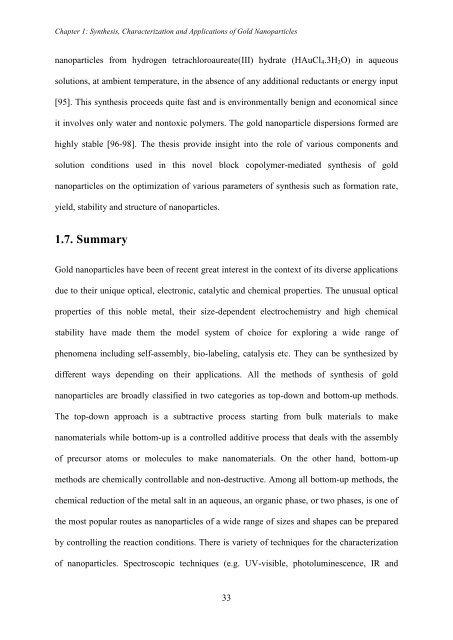PHYS01200704032 Debes Ray - Homi Bhabha National Institute
PHYS01200704032 Debes Ray - Homi Bhabha National Institute
PHYS01200704032 Debes Ray - Homi Bhabha National Institute
You also want an ePaper? Increase the reach of your titles
YUMPU automatically turns print PDFs into web optimized ePapers that Google loves.
Chapter 1: Synthesis, Characterization and Applications of Gold Nanoparticles<br />
nanoparticles from hydrogen tetrachloroaureate(III) hydrate (HAuCl 4 .3H 2 O) in aqueous<br />
solutions, at ambient temperature, in the absence of any additional reductants or energy input<br />
[95]. This synthesis proceeds quite fast and is environmentally benign and economical since<br />
it involves only water and nontoxic polymers. The gold nanoparticle dispersions formed are<br />
highly stable [96-98]. The thesis provide insight into the role of various components and<br />
solution conditions used in this novel block copolymer-mediated synthesis of gold<br />
nanoparticles on the optimization of various parameters of synthesis such as formation rate,<br />
yield, stability and structure of nanoparticles.<br />
1.7. Summary<br />
Gold nanoparticles have been of recent great interest in the context of its diverse applications<br />
due to their unique optical, electronic, catalytic and chemical properties. The unusual optical<br />
properties of this noble metal, their size-dependent electrochemistry and high chemical<br />
stability have made them the model system of choice for exploring a wide range of<br />
phenomena including self-assembly, bio-labeling, catalysis etc. They can be synthesized by<br />
different ways depending on their applications. All the methods of synthesis of gold<br />
nanoparticles are broadly classified in two categories as top-down and bottom-up methods.<br />
The top-down approach is a subtractive process starting from bulk materials to make<br />
nanomaterials while bottom-up is a controlled additive process that deals with the assembly<br />
of precursor atoms or molecules to make nanomaterials. On the other hand, bottom-up<br />
methods are chemically controllable and non-destructive. Among all bottom-up methods, the<br />
chemical reduction of the metal salt in an aqueous, an organic phase, or two phases, is one of<br />
the most popular routes as nanoparticles of a wide range of sizes and shapes can be prepared<br />
by controlling the reaction conditions. There is variety of techniques for the characterization<br />
of nanoparticles. Spectroscopic techniques (e.g. UV-visible, photoluminescence, IR and<br />
33

















